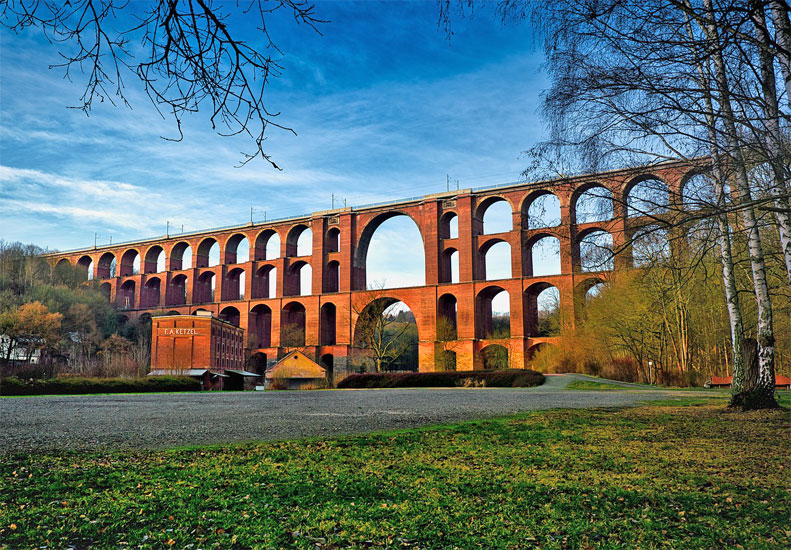The Goltzschtal Bridge – Göltzsch Viaduct is a railway viaduct in Germany, the largest brick bridge in the world. It crosses the Goltzsch valley between Mylau and Netzschkau, approximately 4 km from Reichenbach im Vogtland in Saxony, along the border between Thuringia and Saxony in Greiz.( Vogtland is a geographical region of Germany and the Czech Republic, located between the lands of Bavaria, Thuringia and Saxony and the Bohemian region ).
Golchtalbrucke is the world’s largest brick viaduct. This railway bridge was built between 1846 and 1851, more than 26 million bricks were used in its construction.
The bridge passes along the Golch river valley between the cities of Milau and Nechkau, 4 km west of the city of Reichenbach im Vogtland (Saxony), near the border between the federal states of Thuringia and Saxony near the town of Greitz.
The construction of a bridge across the Goltzschtal was decided upon as part of the construction of the railway from Leipzig to Nuremberg by the Sachsisch-Bayerische Eisenbahn-Compagnie.
The bridge was completed in 1851, and at the time of the inauguration it was the tallest in the world.
Access : Coordinates: 50.6225, 12.245833 / Public transportation :
If you arrive by bus, get off at the bus stop in Mylau “Goltzschtalbrucke branch” / From Greiz – (A 9) approx. 8 km- From direction Hof – (A 72) approx. 12 km –
/ Park : There is a large public car park directly at the bridge.
Highlights :
- The bridge is currently part of the Dresden-Nuremberg expressway., Trains still cross the railway bridge every day. This construct withstands tons of tensile load.
- Overview of technical data : The height of the bridge is 78 meters, length – 574 meters, width at the base – 23 meters. The four-story bridge has 29 spans , Main building material: brick , Construction period: 1846 – 1851
Construction costs: approx.2,200,000 thalers (approx. 26 million, 6,600,000 gold marks) - The large central arch was closed on September 29, 1849, the keystone was laid on September 14, 1850, and on July 15, 1851 the bridge and the Elster Valley Bridge were opened for train traffic.
- The monumental building of the Goltzschtalbrucke can be spotted from numerous places in the area. But by far the most beautiful distant view is in Netzschkau- lookout point is Netzschkau near Hermann-Lons-Strasse
Activities : sightseeing / photo opportunities / trekking-The Goltzschtalbrucke is at the end of the middle Goltzschtal (seen in the flow direction of the Goltzsch). It can serve as the end or start point of a hike.
/ Vogtland Panorama Road Bike Tour / Vogtland Dam Tour / Thuringian Long Distance Cycling Routes 10 – Euregio-Egrensis Long Distance Cycling / Motorbike tour through the Vogtland /
Go next : town of Greiz , the old Thuringian residence of the Princes Reuss a.L. with remarkable tourist sights./ Netzschkau Castle, one of the first residential castles in Saxony, built in 1492 in the Baroque style / Netzschkau , a town in the Vogtlandkreis district, in the Free State of Saxony, Germany.

